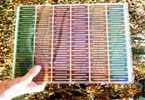Cheap Solar Power a Step Closer
Massey University researchers have developed a novel means of harnessing solar energy, at a fraction of the price. Scientists at the university’s Nanomaterials Research Centre have produced a range of coloured synthetic dyes for use in dye-sensitised solar cells. The synthetic dyes are based on light-harvesting compounds found in nature, such as chlorophyll and haemoglobin, and are made from titanium dioxide – a plentiful, renewable and non-toxic mineral found in NZ black sand. The dye-sensitised cells cost a tenth of the price of currently available silicon-based solar cells, and are more efficient to run and produce. “The refining of pure silicon, although a very abundant mineral, is energy-hungry and very expensive. And whereas silicon cells need direct sunlight to operate efficiently, these cells will work efficiently in low diffuse light conditions,” says study leader Dr Wayne Campbell. “The next step is to take these dyes and incorporate them into roofing materials or wall panels.” The solar cells are the result of more than ten years research funded by NZ’s Foundation for Research, Science and Technology.














